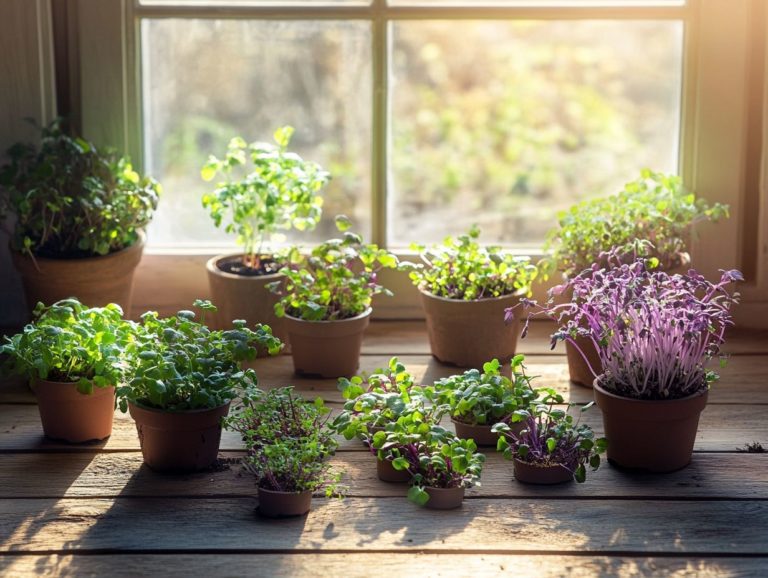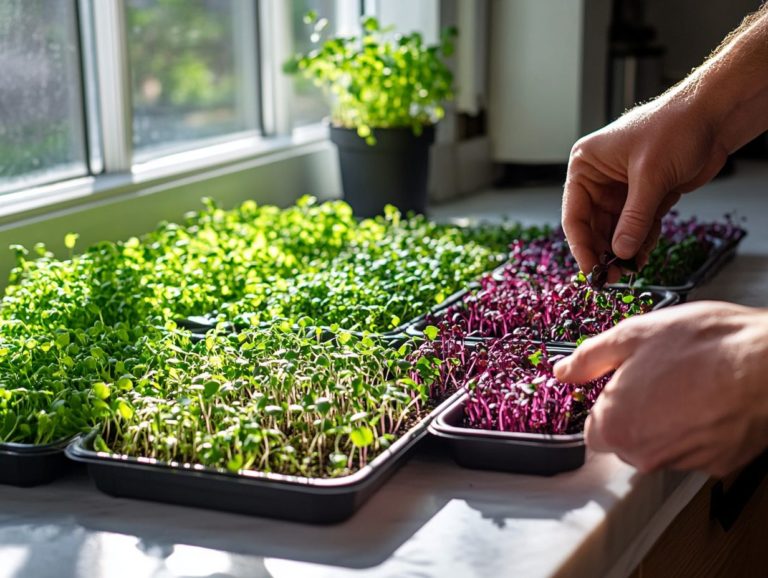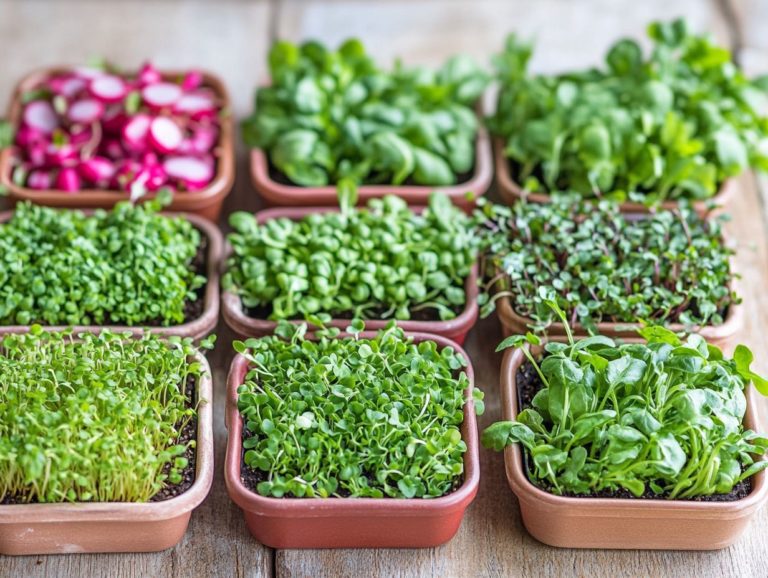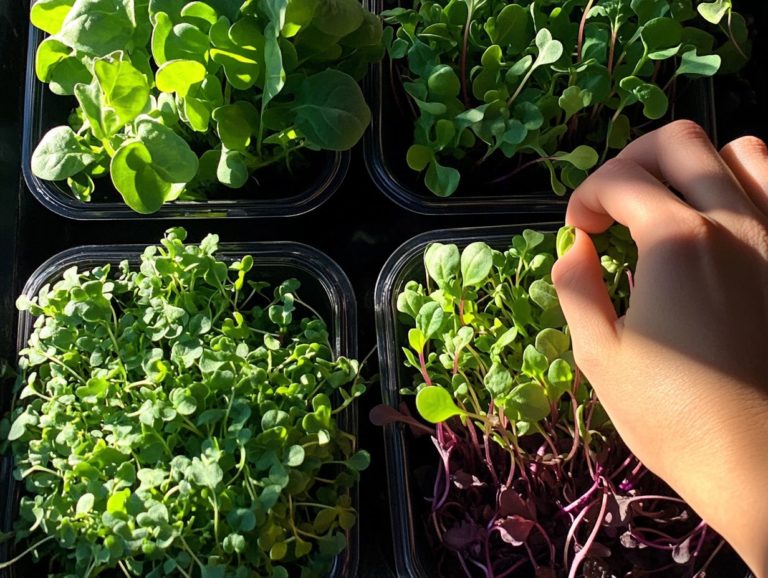How to Grow Your Favorite Microgreen Varieties
Microgreens have truly transformed the cooking world, delivering an explosion of flavor and nutrition in an astonishingly compact form. This step-by-step guide will help you navigate the world of growing microgreens at home.
These vibrant little greens are easy to grow and packed with nutrients, making them an exceptional enhancement to any dish.
Imagine the benefits of cultivating your own microgreens: saving money while improving your health. This article guides you through selecting the right varieties, essential supplies, and practical steps for a successful harvest.
It also addresses common challenges and offers inventive ways to infuse these delightful greens into your cooking. Get ready to transform your meals with the magic of microgreens!
Contents
- Key Takeaways:
- Benefits of Growing Microgreens
- Choosing the Right Microgreens to Grow
- Supplies and Equipment Needed
- Steps for Growing Microgreens
- Troubleshooting Common Issues
- Creative Ways to Use Microgreens
- Frequently Asked Questions
- What are microgreens and why are they popular?
- What are some popular microgreen varieties for growing at home?
- How do I prepare the soil for growing microgreens?
- What is the best way to sow seeds for microgreens?
- How do I care for my microgreens as they grow?
- Can I reuse the soil after harvesting my microgreens?
Key Takeaways:

- Incorporating microgreens into your diet can provide cost savings and a variety of nutritional benefits.
- When choosing which microgreens to grow, consider factors such as time, space, and personal preferences.
- With essential tools and materials, and the right steps for growing, you can easily troubleshoot and incorporate microgreens into your meals and recipes.
Discover the World of Microgreens!
Microgreens are those vibrant, young edible plants you can harvest just 7 to 21 days after germination, and they re bursting with flavor and nutrients. Think of varieties like radishes, broccoli, and kale they re not only visually appealing but also incredibly easy to grow in small spaces, making them an ideal fit for your home or indoor gardening setup. Experts like Francesco Di Gioia at Penn State have highlighted their potential health benefits and versatility in the kitchen.
The beauty of microgreens lies in their bold taste and adaptability; you can grow them on a windowsill or your kitchen countertop, using just soil or even growing plants in water without soil. This flexibility invites you to experiment, turning a simple gardening hobby into a source of fresh ingredients for your culinary creations. If you’re looking to maximize your growing efforts, consider learning how to use a grow tent for microgreens.
Plus, the nutritional punch these tiny greens pack is impressive they often contain higher concentrations of vitamins and minerals compared to their fully grown counterparts. Popular varieties like basil, cilantro, and sunflower not only elevate the flavor profile of your dishes but also make them visually enticing, contributing to the growing trend of microgreens in both home kitchens and upscale dining establishments.
Benefits of Growing Microgreens
Growing microgreens presents you with a wealth of advantages, significantly enriching your diet while also saving you money compared to buying these nutrient-packed greens at the store. With their impressive array of essential vitamins and minerals think potassium, iron, zinc, and vitamin C microgreens effortlessly elevate the nutritional value of your meals, all while being remarkably easy to grow in a variety of home gardening setups.
They add a fresh and flavorful twist to your dishes and provide economic benefits, allowing you to cultivate your own greens year-round and reduce your dependence on store-bought alternatives.
Why wait? Start growing your own microgreens today and enjoy fresh flavors in your meals!
Nutritional Value and Cost Savings
Microgreens are celebrated for their remarkable nutritional value, often boasting higher concentrations of essential nutrients than their mature counterparts. This makes them an outstanding addition to your healthy diet. Growing microgreens at home can save you a lot of money. With just a modest investment in seeds and growing containers, you can harvest a bounty that would otherwise cost a pretty penny at the store.
Nutrients like potassium, iron, zinc, and vitamin C found in microgreens such as kale, broccoli, and radishes not only boost your health but also enhance the flavor profile of your dishes. Studies show that just an ounce of certain microgreens can deliver an astonishing amount of nutrients, often surpassing what you d find in an entire cup of their adult versions.
For those dedicated to healthy eating, tapping into the power of microgreens can truly transform your meals and elevate your nutritional intake all without breaking the bank. The financial benefits become crystal clear when you grow them yourself. A single pack of seeds can yield multiple harvests, significantly cutting costs while providing you with fresh, home-grown ingredients.
The convenience of having these nutrient-packed gems at your fingertips encourages more consistent use, enhancing both the variety and enjoyment of your diet.
Choosing the Right Microgreens to Grow
Ready to grow your own microgreens? Selecting the ideal microgreens for your home garden is key to ensuring success. Different varieties bring unique flavors, textures, and nutritional benefits, perfectly catering to a range of culinary preferences.
As you embark on this journey, consider your growing medium, light, and container types to succeed. Some popular choices include nutrient-rich greens such as sunflower, peas, and clover. Each one not only offers a distinct taste and appearance but is also straightforward to grow in containers, allowing you to elevate your dishes effortlessly. To learn more about improving your harvest, check out this guide on how to maximize yields from microgreens.
Factors to Consider
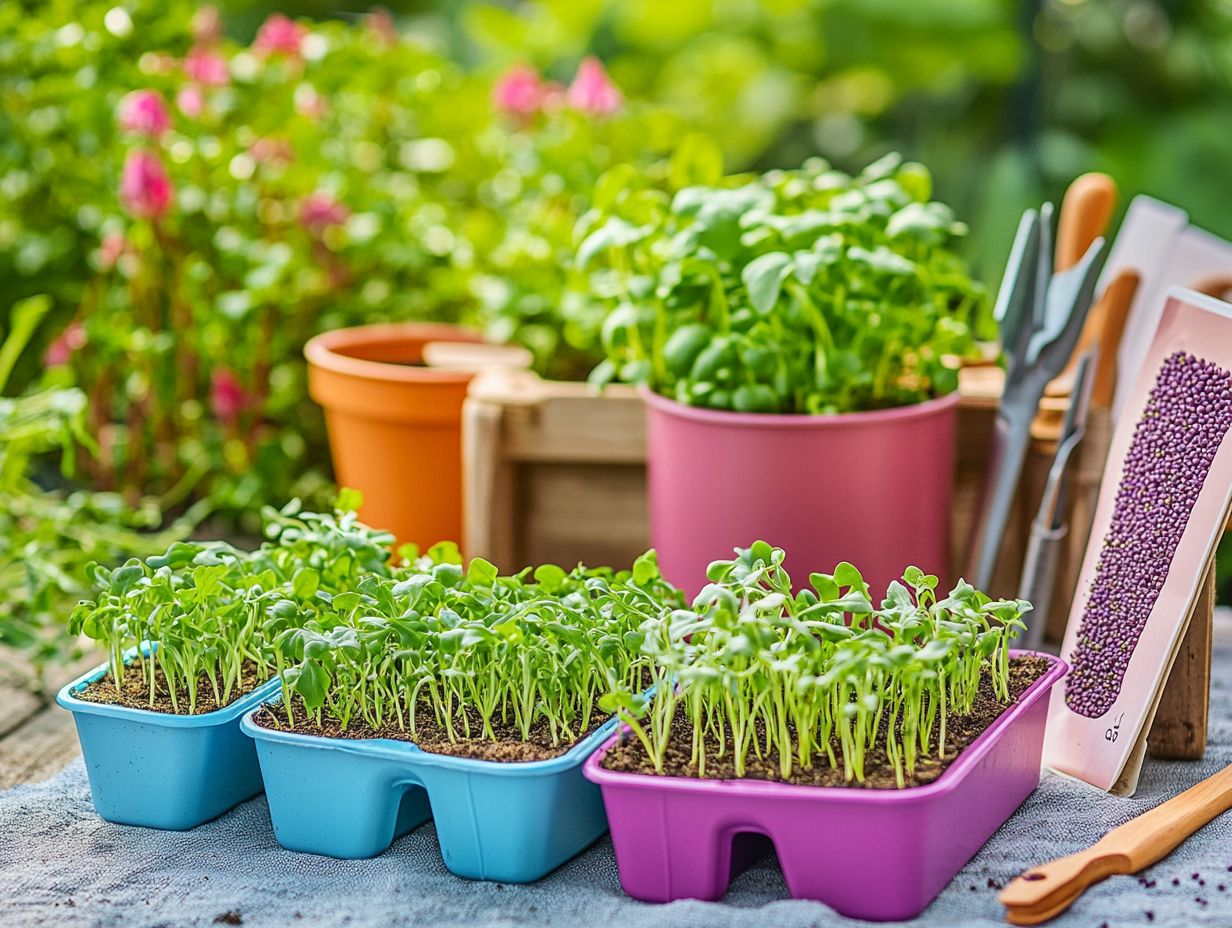
When selecting microgreens for your home gardening venture, act now! Here are key factors to boost your success. Think about the growing medium, light conditions, and the type of containers suited for your space. Understanding these elements is essential for achieving optimal plant growth and reaping a successful harvest.
Some microgreens flourish in soil, while others grow in a way without soil. Knowing this empowers you to make informed decisions about which nutrient-dense greens to grow in your indoor garden. If you’re interested in getting started, check out this guide on how to start a microgreen garden for beginners.
Light conditions are equally critical; most microgreens need at least 12-16 hours of light daily, so investing in quality grow lights can significantly enhance your results. For those looking to optimize their indoor gardening, exploring techniques for growing microgreens year-round is beneficial. Temperature is another vital aspect, as many microgreens prosper between 60 F and 75 F, making your indoor climate an important consideration.
The space you have available will also influence your choices. Some varieties require more room to grow, while others can be sown in compact trays. And let’s not forget personal taste preferences; selecting flavors and textures that align with your culinary style will transform your microgreen gardening journey into a productive and enjoyable experience. For those interested in maximizing their yield, learning how to use hydroponics for microgreens can be a game-changer.
Supplies and Equipment Needed
You’ll need essential supplies to grow microgreens at home. Choosing the right growing containers is vital; they come in various sizes and types, providing the necessary space and drainage for your seedlings during the germination process.
Plus containers, don t overlook other critical supplies like seeds, growing mediums, and watering tools. These elements are crucial for creating a flourishing indoor gardening environment.
Essential Tools and Materials
To cultivate microgreens successfully, you ll want to gather essential tools and materials: seed trays, high-quality seeds, an appropriate growing medium, and watering equipment. These elements create the ideal conditions for germination and growth.
Adding items like measuring cups for soaking seeds and scissors for harvesting will elevate your gardening experience. This allows you to manage your home garden with ease. Selecting the right materials lays the foundation for thriving growth, and understanding how to rotate crops for microgreens enables you to savor the vibrant flavors and nutritional benefits of your homegrown microgreens.
Remember, proper drainage is crucial. Using trays with holes or a drainage layer will help you avoid pesky waterlogging. If you’re gardening indoors, a good-quality grow light is critical, providing the necessary illumination for optimal growth, particularly during those shorter daylight months.
A humidity dome can also play a key role in maintaining moisture levels, supporting your seedlings as they emerge. Equipping yourself with a pH meter helps ensure that your growing medium remains balanced, which is vital for the health of those delicate greens.
By arming yourself with these essential tools and materials, your microgreens will thrive, bringing abundance and freshness straight to your table.
Steps for Growing Microgreens
The process of growing microgreens is a careful process that starts with selecting the perfect seeds and culminates in the satisfying experience of harvesting your own greens. This comprehensive step-by-step guide outlines essential phases for growing microgreens, including:
- Preparing the growing medium
- Planting the seeds
- Maintaining optimal moisture levels
- Carefully monitoring the germination process
Each step is pivotal for achieving a bountiful harvest. As you navigate this journey, you’ll discover that each stage enhances the quality and flavor of these nutrient-dense greens. Additionally, understanding the perfect light conditions for microgreens will elevate your meals while nurturing your commitment to a healthy diet through home gardening.
From Seed to Harvest
The journey from seed to harvest for microgreens is a captivating process that typically unfolds in just a few weeks. It requires your keen attention to detail to ensure successful growth and delightful flavors.
During germination, seeds soak up water and begin to sprout. This highlights the necessity of maintaining proper moisture levels and light exposure.
As your microgreens transition into young plants, it becomes essential to uphold optimal temperature and humidity. These elements significantly influence growth rates and overall quality. Regularly monitoring soil moisture promotes healthy root development, while gentle light sources are crucial. For more details, refer to this guide on how to use grow lights for microgreens to avoid that dreaded leggy growth (plants that grow tall and thin due to inadequate light).
Once those seedlings develop their first true leaves, you re just about ready to harvest. Remember, this should be done with care to preserve their delicate structure and exquisite flavor.
By mastering each stage of this process, you can cultivate a vibrant mix of microgreens, each offering distinct tastes and nutritional benefits to elevate your culinary creations.
Troubleshooting Common Issues
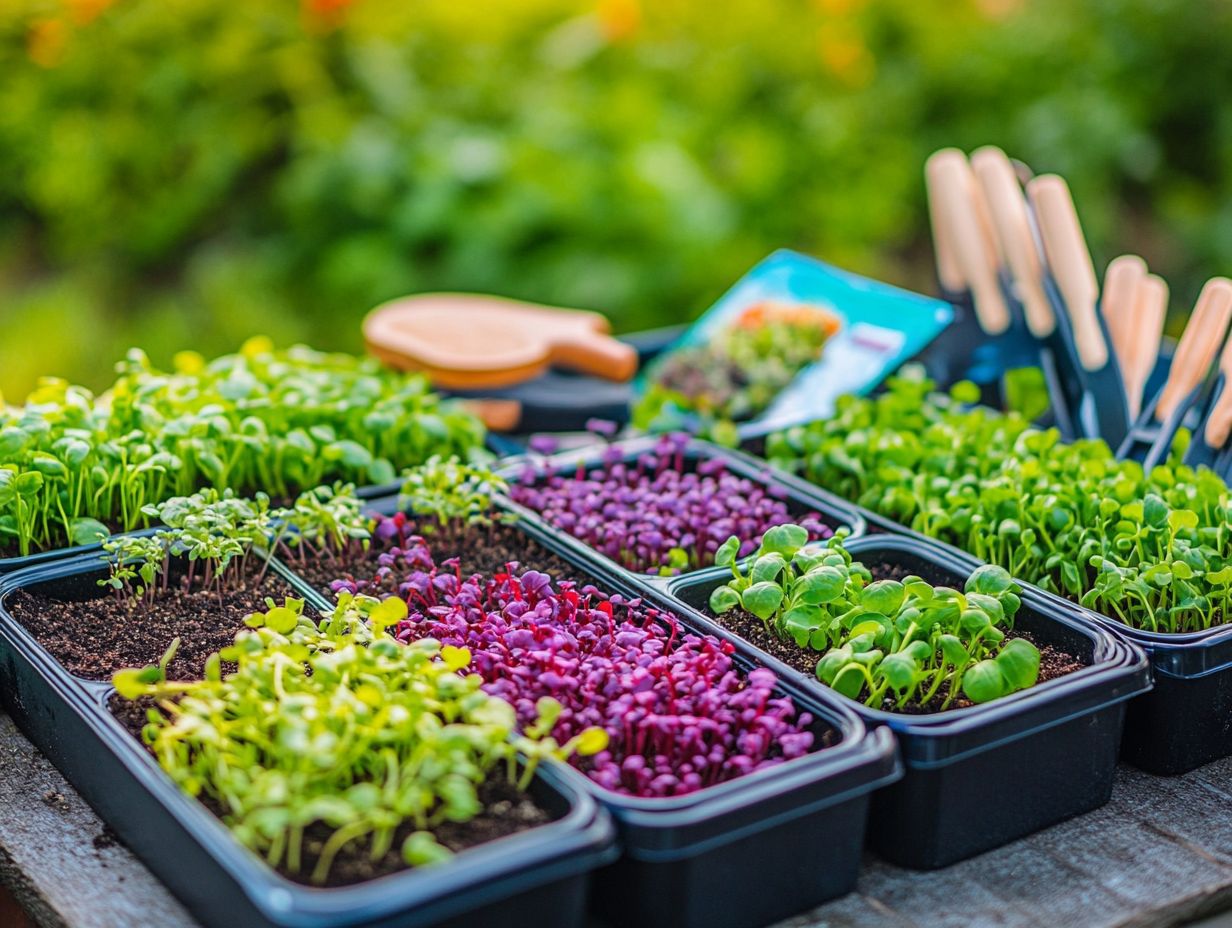
Troubleshooting common issues in your microgreen journey is essential to ensure you enjoy a thriving harvest and preserving the health of your indoor gardening setup. Whether it s pests lurking around your seedlings or diseases threatening their growth, grasping these potential challenges gives you the power to take proactive steps.
By recognizing symptoms early and employing effective strategies, you can safeguard your microgreens, ensuring that you continue to relish their nutritional benefits in your diet.
Dealing with Pests and Diseases
Managing pests and diseases in your microgreen garden is crucial for getting great results in your home garden. These challenges can significantly impact the growth and quality of your crops.
From pesky spider mites to intrusive whiteflies, a variety of unwelcome visitors can disrupt the delicate balance needed for flourishing microgreens. Soil-borne pathogens can also appear, especially when overwatering or poor drainage occurs, leading to issues like root rot, which is when plant roots decay due to excess moisture.
To effectively combat these foes, try implementing crop rotation, which means changing the types of plants grown in an area to help prevent pests and diseases. Keeping your growing trays impeccably clean is also essential, informed by agricultural research from experts like Francesco Di Gioia at Penn State.
Introducing beneficial insects like ladybugs can be a game-changer in maintaining control over harmful pest populations. Regular monitoring, along with the strategic use of neem oil or insecticidal soap, can effectively protect your microgreens from infestations and diseases.
By taking these proactive measures, you can cultivate a thriving garden that rewards you with vibrant, nutrient-dense crops.
Creative Ways to Use Microgreens
Exploring creative ways to use microgreens can truly elevate your meals, infusing them with flair, flavor, and nutritional value. These versatile greens enhance salads, sandwiches, smoothies, and even serve as exquisite garnishes for soups and main courses.
By experimenting with different microgreen varieties, you ll uncover unique flavor pairings that transform your culinary creations, ensuring that healthy eating is both beneficial and delightful.
Incorporating Them into Meals and Recipes
Incorporating microgreens into your meals not only elevates the visual appeal of your dishes but also amplifies their nutritional content, making healthy eating far more enticing. These vibrant greens can be sprinkled atop pizzas, blended into smoothies, or added to omelets, transforming ordinary recipes into extraordinary culinary experiences.
The versatility of microgreens invites endless creativity in meal preparation, ensuring they can be enjoyed in many healthy and delicious ways. For those looking to cultivate their own, a step-by-step guide to sowing microgreens can be incredibly helpful.
With their striking colors and distinctive flavors, microgreens like arugula or radish can provide a peppery counterpoint to rich ingredients such as creamy risottos or robust meats. Imagine garnishing a light salad with sunflower microgreens for a delightful nutty taste, or tossing them into a stir-fry for extra crunch and nutrition, especially with Amaranthaceae varieties. To understand how to best cultivate these vibrant greens, explore the science behind microgreen growth.
Pairing these greens with citrus dressings enhances their freshness, making them the perfect complement to summer dishes. Whether you use them in wraps, soups, or as a bed for grilled fish, integrating microgreens into your menu elevates your meals and inspires a balanced, health-conscious lifestyle.
Frequently Asked Questions
What are microgreens and why are they popular?
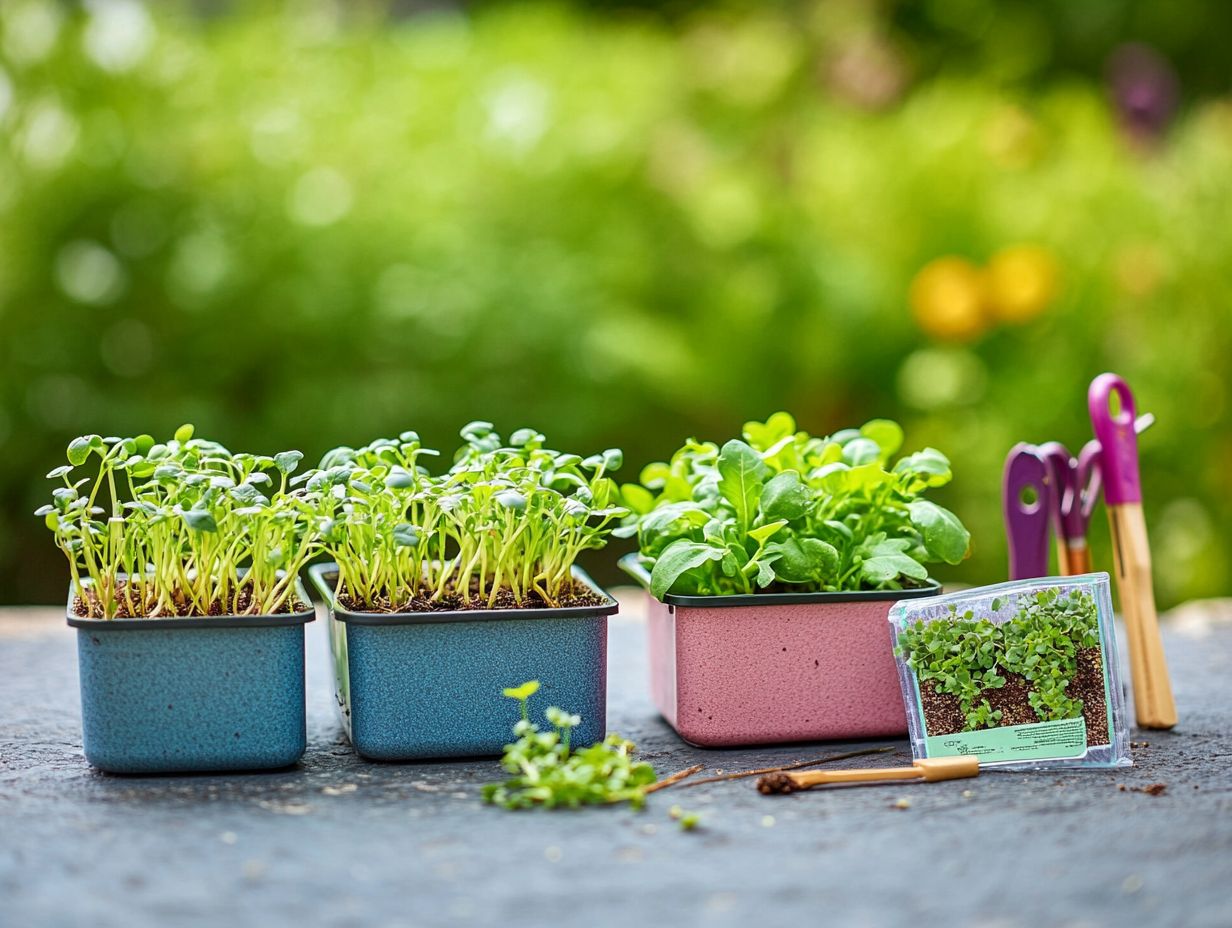
Microgreens are young vegetable plants harvested at the first true leaf stage. They are popular because they are easy to grow, have high nutritional value, and add flavor and texture to dishes.
What are some popular microgreen varieties for growing at home?
Some popular microgreen varieties for growing at home include broccoli, kale, radish, sunflower, and pea shoots. These varieties are easy to grow and have delicious flavors.
How do I prepare the soil for growing microgreens?
For growing microgreens, you can use a seed starting mix or a potting mix. Ensure the soil is well-draining and has a good balance of nutrients. It’s also important to keep the soil moist but not waterlogged.
What is the best way to sow seeds for microgreens?
The best way to sow seeds for microgreens is to scatter them evenly over the soil surface. Lightly press them down to ensure good contact with the soil.
You can use a seed tray or container with holes at the bottom to help with drainage, which is essential for healthy growth. Then, evenly spread the seeds on top of the soil.
How do I care for my microgreens as they grow?
Watch your microgreens thrive! Keep the soil moist and give them plenty of light.
You can use a spray bottle to mist the leaves and keep them hydrated. Once your microgreens reach the perfect height, don t wait! Snip off the stems just above the soil for the freshest taste.
Can I reuse the soil after harvesting my microgreens?
Yes, you can reuse the soil after harvesting your microgreens. However, it’s important to replenish the soil with nutrients before sowing new seeds.
Add compost or a balanced organic fertilizer to revitalize the soil for your next batch of microgreens.


